Paper Menu >>
Journal Menu >>
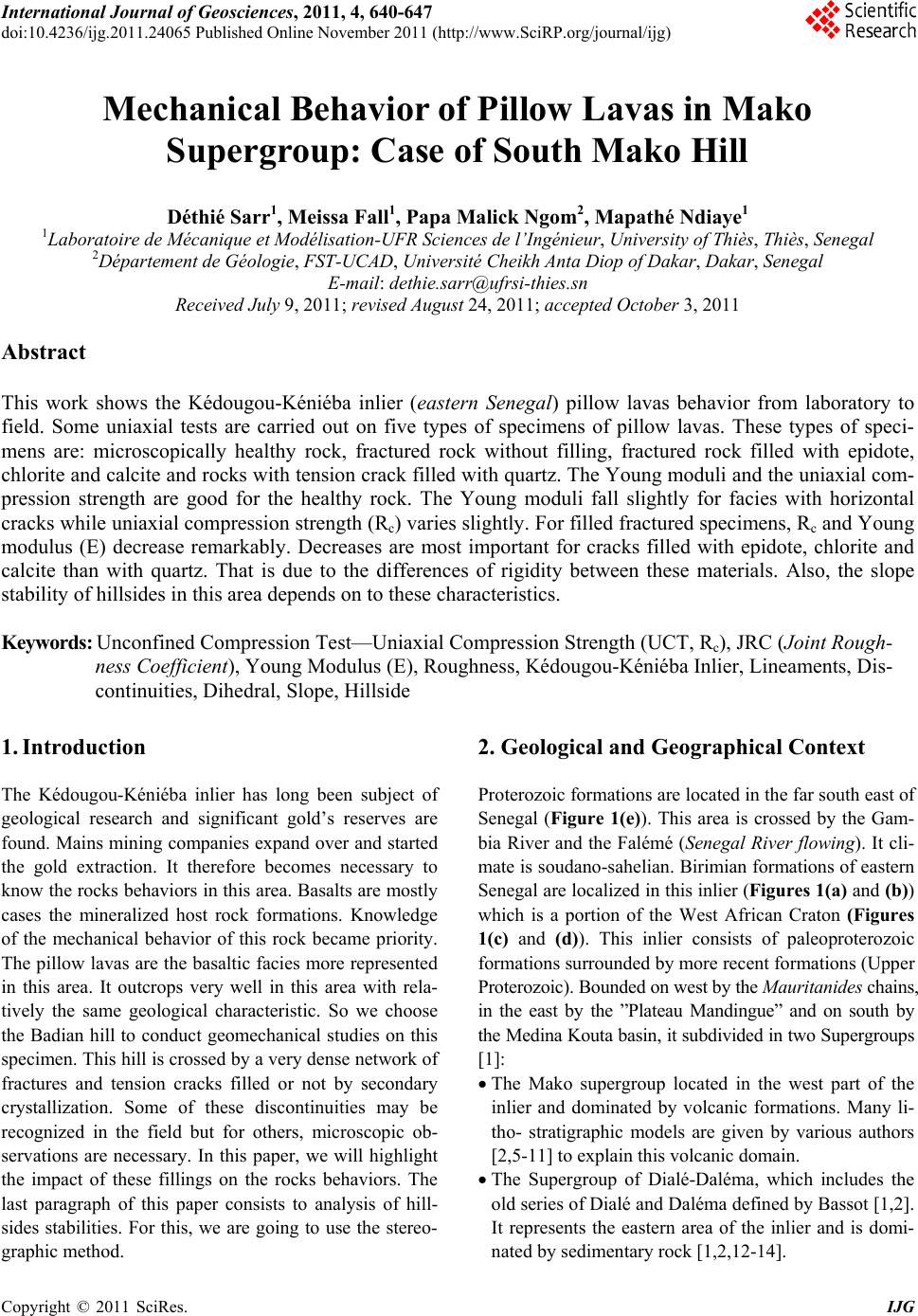 International Journal of Geosciences, 2011, 4, 640-647 doi:10.4236/ijg.2011.24065 Published Online November 2011 (http://www.SciRP.org/journal/ijg) Copyright © 2011 SciRes. IJG Mechanical Behavior of Pillow Lavas in Mako Supergroup: Case of South Mako Hill Déthié Sarr1, Meissa Fall1, Papa Malick Ngom2, Mapathé Ndiaye1 1Laboratoire de Mécanique et Modélisation-UFR Scienc es de l’Ingénieur, University of Thiès, Thiès, Senegal 2Département de Géologie, FST-UCAD, Université Cheikh Anta Diop of Dakar, Dakar, Senegal E-mail: dethie.sarr@ufrsi-thies.sn Received July 9, 2011; revised August 24, 2011; accepted October 3, 2011 Abstract This work shows the Kédougou-Kéniéba inlier (eastern Senegal) pillow lavas behavior from laboratory to field. Some uniaxial tests are carried out on five types of specimens of pillow lavas. These types of speci- mens are: microscopically healthy rock, fractured rock without filling, fractured rock filled with epidote, chlorite and calcite and rocks with tension crack filled with quartz. The Young moduli and the uniaxial com- pression strength are good for the healthy rock. The Young moduli fall slightly for facies with horizontal cracks while uniaxial compression strength (Rc) varies slightly. For filled fractured specimens, Rc and Young modulus (E) decrease remarkably. Decreases are most important for cracks filled with epidote, chlorite and calcite than with quartz. That is due to the differences of rigidity between these materials. Also, the slope stability of hillsides in this area depends on to these characteristics. Keywords: Unconfined Compression Test—Uniaxial Compression Strength (UCT, Rc), JRC (Joint Rough- ness Coefficient), Young Modulus (E), Roughness, Kédougou-Kéniéba Inlier, Lineaments, Dis- continuities, Dihedral, Slope, Hillside 1. Introduction The Kédougou-Kéniéba inlier has long been subject of geological research and significant gold’s reserves are found. Mains mining companies expand over and started the gold extraction. It therefore becomes necessary to know the rocks behaviors in this area. Basalts are mostly cases the mineralized host rock formations. Knowledge of the mechanical behavior of this rock became priority. The pillow lavas are the basaltic facies more represented in this area. It outcrops very well in this area with rela- tively the same geological characteristic. So we choose the Badian hill to conduct geomechanical studies on this specimen. This hill is crossed by a very dense network of fractures and tension cracks filled or not by secondary crystallization. Some of these discontinuities may be recognized in the field but for others, microscopic ob- servations are necessary. In this paper, we will highlight the impact of these fillings on the rocks behaviors. The last paragraph of this paper consists to analysis of hill- sides stabilities. For this, we are going to use the stereo- graphic method. 2. Geological and Geographical Context Proterozoic formations are located in the far south east of Senegal (Figure 1(e)). This area is crossed by the Gam- bia River and the Falémé (Senegal River flowing). It cli- mate is soudano-sahelian. Birimian formations of eastern Senegal are localized in this inlier (Figures 1(a) and (b)) which is a portion of the West African Craton (Figures 1(c) and (d)). This inlier consists of paleoproterozoic formations surrounded by more recent formations (Upper Proterozoic). Bounded on west by the Mauritanides chains, in the east by the ”Plateau Mandingue” and on south by the Medina Kouta basin, it subdivided in two Supergroups [1]: The Mako supergroup located in the west part of the inlier and dominated by volcanic formations. Many li- tho- stratigraphic models are given by various authors [2,5-11] to explain this volcanic domain. The Supergroup of Dialé-Daléma, which includes the old series of Dialé and Daléma defined by Bassot [1,2]. It represents the eastern area of the inlier and is domi- nated by sedimentary rock [1,2,12-14]. 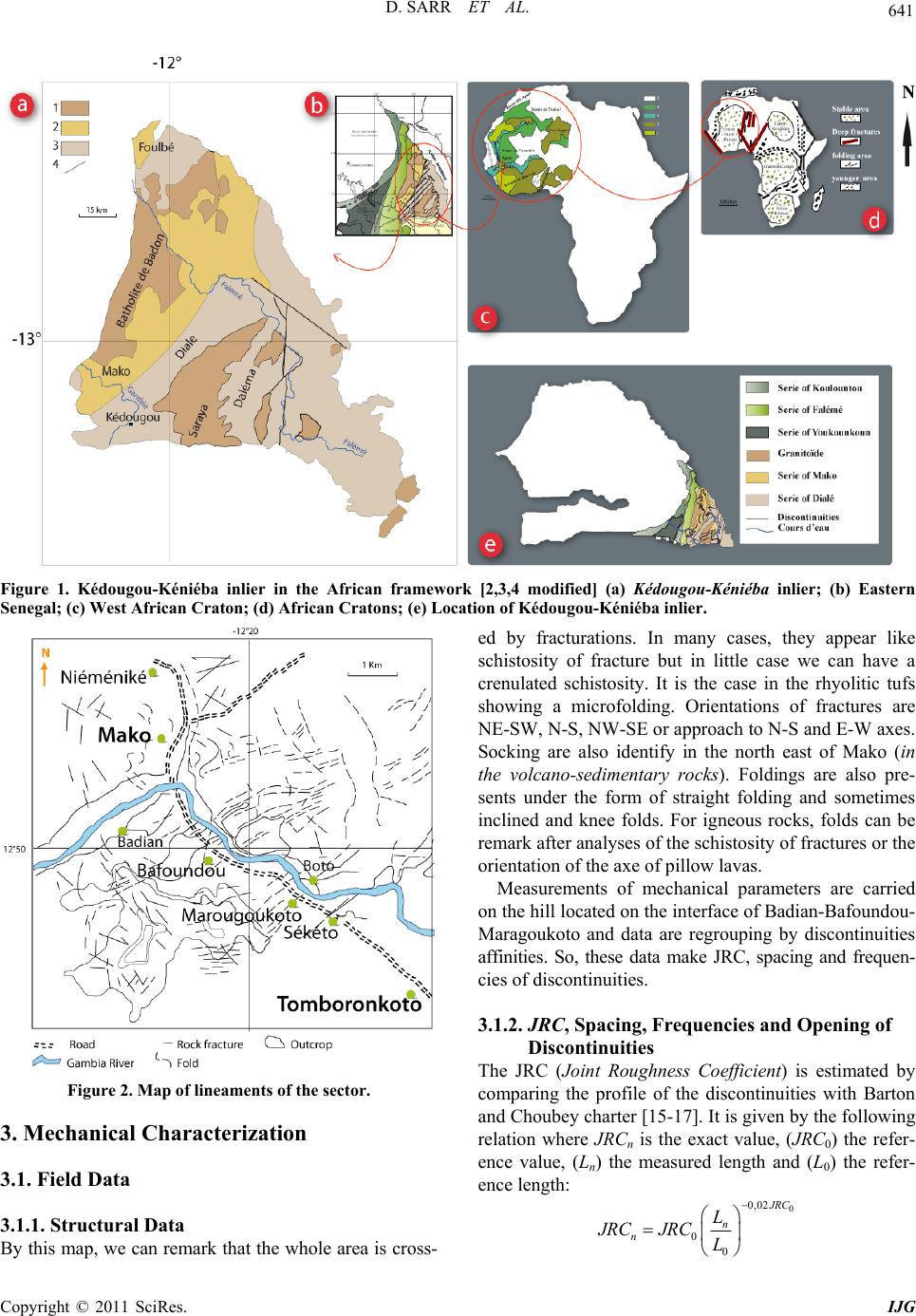 D. SARR ET AL. Copyright © 2011 SciRes. IJG 641 Figure 1. Kédougou-Kéniéba inlier in the African framework [2,3,4 modified] (a) Kédougou-Kéniéba inlier; (b) Eastern Senegal; (c) West African Craton; (d) African Cratons; (e) Location of Kédougou-Kéniéba inlier. Figure 2. Map of lineaments of the sector. 3. Mechanical Characterization 3.1. Field Data 3.1.1. Structural Data By this map, we can remark that the whole area is cross- ed by fracturations. In many cases, they appear like schistosity of fracture but in little case we can have a crenulated schistosity. It is the case in the rhyolitic tufs showing a microfolding. Orientations of fractures are NE-SW, N-S, NW-SE or approach to N-S and E-W axes. Socking are also identify in the north east of Mako (in the volcano-sedimentary rocks). Foldings are also pre- sents under the form of straight folding and sometimes inclined and knee folds. For igneous rocks, folds can be remark after analyses of the schistosity of fractures or the orientation of the axe of pillow lavas. Measurements of mechanical parameters are carried on the hill located on the interface of Badian-Bafoundou- Maragoukoto and data are regrouping by discontinuities affinities. So, these data make JRC, spacing and frequen- cies of discontinuities. 3.1.2. JRC, Spacing, Frequencies and Opening of Discontinuities The JRC (Joint Roughness Coefficient) is estimated by comparing the profile of the discontinuities with Barton and Choubey charter [15-17]. It is given by the following relation where JRCn is the exact value, (JRC0) the refer- ence value, (Ln) the measured length and (L0) the refer- ence length: 0 0,02 00 J RC n nL JRCJRC L 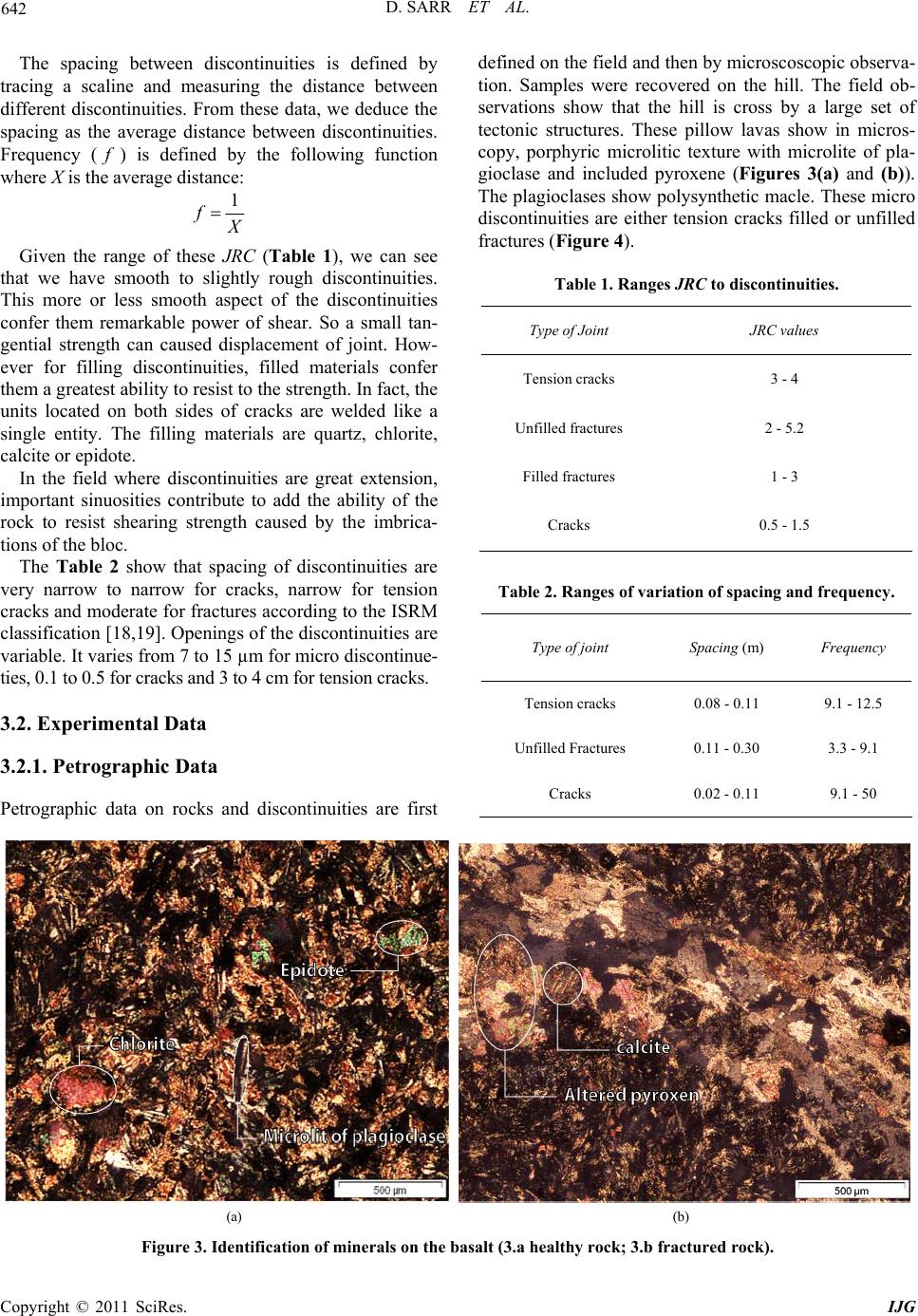 D. SARR ET AL. Copyright © 2011 SciRes. IJG 642 The spacing between discontinuities is defined by tracing a scaline and measuring the distance between different discontinuities. From these data, we deduce the spacing as the average distance between discontinuities. Frequency ( f ) is defined by the following function where X is the average distance: 1 f X Given the range of these JRC (Table 1), we can see that we have smooth to slightly rough discontinuities. This more or less smooth aspect of the discontinuities confer them remarkable power of shear. So a small tan- gential strength can caused displacement of joint. How- ever for filling discontinuities, filled materials confer them a greatest ability to resist to the strength. In fact, the units located on both sides of cracks are welded like a single entity. The filling materials are quartz, chlorite, calcite or epidote. In the field where discontinuities are great extension, important sinuosities contribute to add the ability of the rock to resist shearing strength caused by the imbrica- tions of the bloc. The Table 2 show that spacing of discontinuities are very narrow to narrow for cracks, narrow for tension cracks and moderate for fractures according to the ISRM classification [18,19]. Opening s of the discontinuities are variable. It varies from 7 to 15 µm for micro discontinue- ties, 0.1 to 0.5 for cracks and 3 to 4 cm for tension cracks. 3.2. Experimental Data 3.2.1. Petrographic Data Petrographic data on rocks and discontinuities are first defined on the field and then by microscoscopic observa- tion. Samples were recovered on the hill. The field ob- servations show that the hill is cross by a large set of tectonic structures. These pillow lavas show in micros- copy, porphyric microlitic texture with microlite of pla- gioclase and included pyroxene (Figures 3(a) and (b)). The plagioclases show polysynthetic macle. These micro discontinuities are either tension cracks filled or unfilled fractures (Figure 4). Table 1. Ranges JRC to discontinuities. Type of Joint JRC values Tension cracks 3 - 4 Unfilled fractures 2 - 5.2 Filled fractures 1 - 3 Cracks 0.5 - 1.5 Table 2. Ranges of variation of spacing and frequency. Type of joint Spacing (m) Frequency Tension cracks 0.08 - 0.11 9.1 - 12.5 Unfilled Fractures 0.11 - 0.30 3.3 - 9.1 Cracks 0.02 - 0.11 9.1 - 50 (a) (b) Figure 3. Identification of minerals on the basalt (3.a healthy rock; 3.b fractured rock). 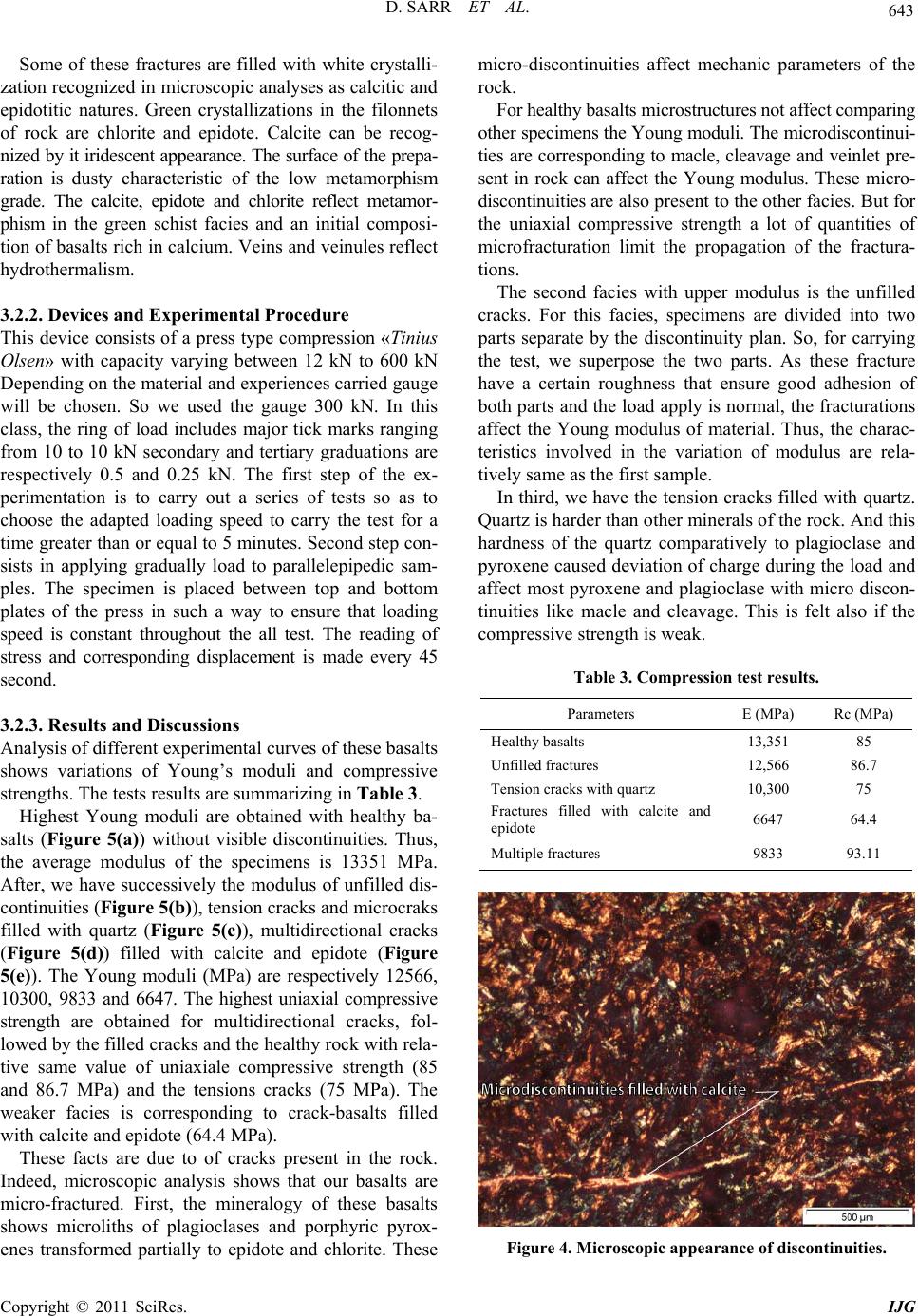 D. SARR ET AL. Copyright © 2011 SciRes. IJG 643 Some of these fractures are filled with white crystalli- zation recognized in microscopic analyses as calcitic and epidotitic natures. Green crystallizations in the filonnets of rock are chlorite and epidote. Calcite can be recog- nized by it iridescent app earance. The surface of the prepa- ration is dusty characteristic of the low metamorphism grade. The calcite, epidote and chlorite reflect metamor- phism in the green schist facies and an initial composi- tion of basalts rich in calcium. Veins and veinules reflect hydrothermalism. 3.2.2. D evices an d Experim en t a l Procedure This device consists of a press type compression «Tinius Olsen» with capacity varying between 12 kN to 600 kN Depending on the material and experiences carried gauge will be chosen. So we used the gauge 300 kN. In this class, the ring of load includes major tick marks ranging from 10 to 10 kN secondary and tertiary graduations are respectively 0.5 and 0.25 kN. The first step of the ex- perimentation is to carry out a series of tests so as to choose the adapted loading speed to carry the test for a time greater than or equal to 5 minutes. Second step con- sists in applying gradually load to parallelepipedic sam- ples. The specimen is placed between top and bottom plates of the press in such a way to ensure that loading speed is constant throughout the all test. The reading of stress and corresponding displacement is made every 45 second. 3.2.3. Results and Discussions Analysis of different experimental curves of these basalts shows variations of Young’s moduli and compressive strengths. The tests results are summarizing in Table 3. Highest Young moduli are obtained with healthy ba- salts (Figure 5(a)) without visible discontinuities. Thus, the average modulus of the specimens is 13351 MPa. After, we have successively the modulus of unfilled dis- continuities (Figure 5(b)), tension cracks and microcraks filled with quartz (Figure 5(c)), multidirectional cracks (Figure 5(d)) filled with calcite and epidote (Figure 5(e)). The Young moduli (MPa) are respectively 12566, 10300, 9833 and 6647. The highest uniaxial compressive strength are obtained for multidirectional cracks, fol- lowed by the filled cracks and the healthy rock with rela- tive same value of uniaxiale compressive strength (85 and 86.7 MPa) and the tensions cracks (75 MPa). The weaker facies is corresponding to crack-basalts filled with calcite and epidote (64.4 MPa). These facts are due to of cracks present in the rock. Indeed, microscopic analysis shows that our basalts are micro-fractured. First, the mineralogy of these basalts shows microliths of plagioclases and porphyric pyrox- enes transformed partially to epidote and chlorite. These micro-discontinuities affect mechanic parameters of the rock. For healthy basalts microstructures not affect compari ng other specimens the Young moduli. The microdiscontinui- ties are corresponding to macle, cleavage and veinlet pre- sent in rock can affect the Young modulus. These micro- discontinuities are also present to the other facies. But for the uniaxial compressive strength a lot of quantities of microfracturation limit the propagation of the fractura- tions. The second facies with upper modulus is the unfilled cracks. For this facies, specimens are divided into two parts separate by the discontinuity plan. So, for carrying the test, we superpose the two parts. As these fracture have a certain roughness that ensure good adhesion of both parts and the load apply is normal, the fracturations affect the Young modulus of material. Thus, the charac- teristics involved in the variation of modulus are rela- tively same as the first sample. In third, we have the tension cracks filled with quartz. Quartz is harder than o ther minerals o f th e rock . And th is hardness of the quartz comparatively to plagioclase and pyroxene caused deviation of charge during the load and affect most pyroxene and plagioclase with micro discon- tinuities like macle and cleavage. This is felt also if the compressive strength is weak. Table 3. Compression test results. Parameters E (MPa) Rc (MPa) Healthy basalts 13,351 85 Unfilled fractures 12,566 86.7 Tension cracks w ith quartz 10,300 75 Fractures filled with calcite and epidote 6647 64.4 Multiple fractures 9833 93.11 Figure 4. Microscopic appearance of discontinuities. 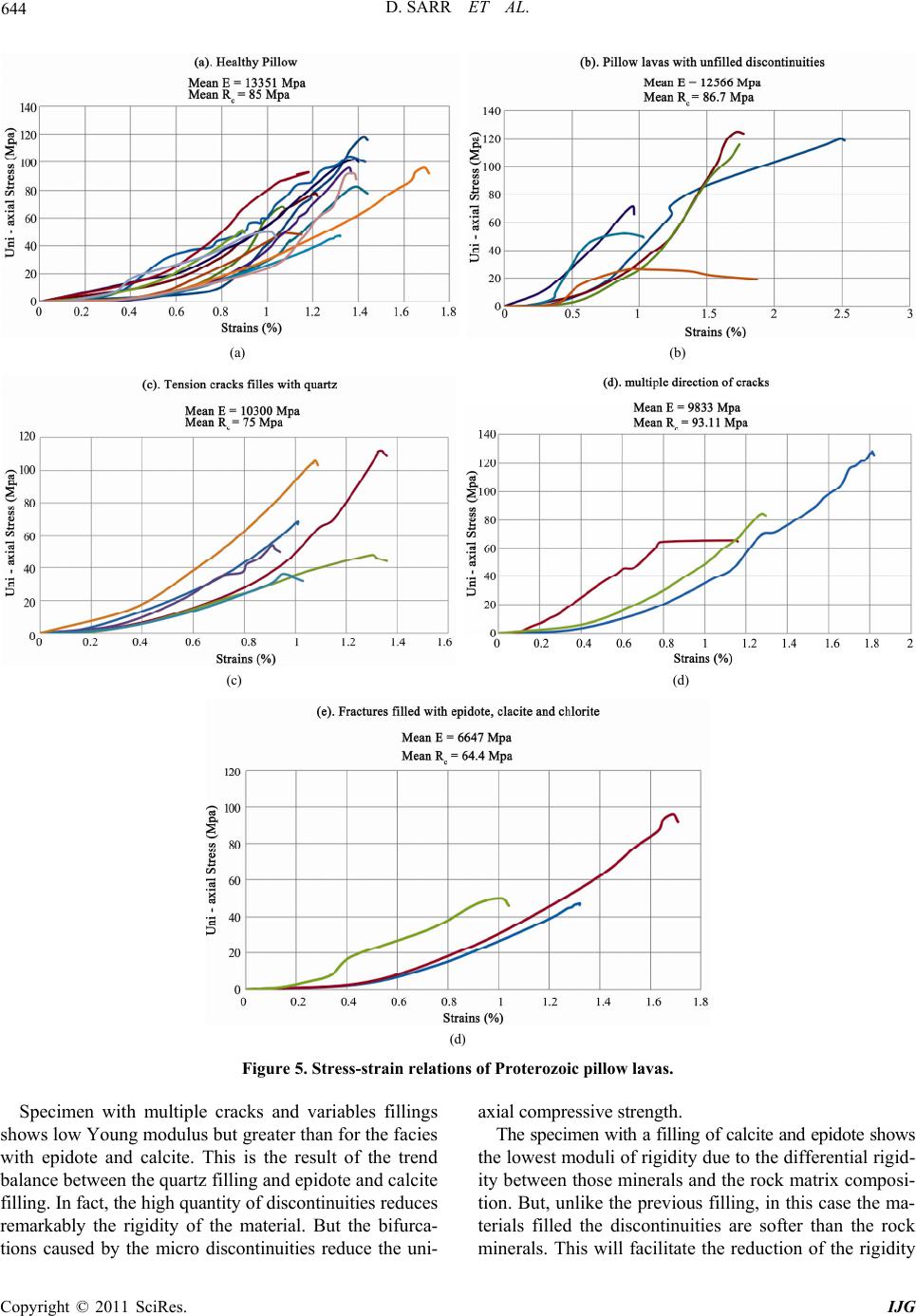 D. SARR ET AL. Copyright © 2011 SciRes. IJG 644 (a) (b) (c) (d) (d) Figure 5. Stress-strain relations of Proterozoic pillow lavas. Specimen with multiple cracks and variables fillings shows low Young modulus but greater than for the facies with epidote and calcite. This is the result of the trend balance between the quartz filling and epidote and calcite filling. In fact, th e high quantity of discontinuities reduces remarkably the rigidity of the material. But the bifurca- tions caused by the micro discontinuities reduce the uni- axial compressive strength. The specimen with a filling of calcite and epidote shows the lowest moduli of rigidity du e to the differential rigid- ity between those minerals and the rock matrix composi- tion. But, unlike the prev ious filling, in this case the ma- terials filled the discontinuities are softer than the rock minerals. This will facilitate the reduction of the rigidity 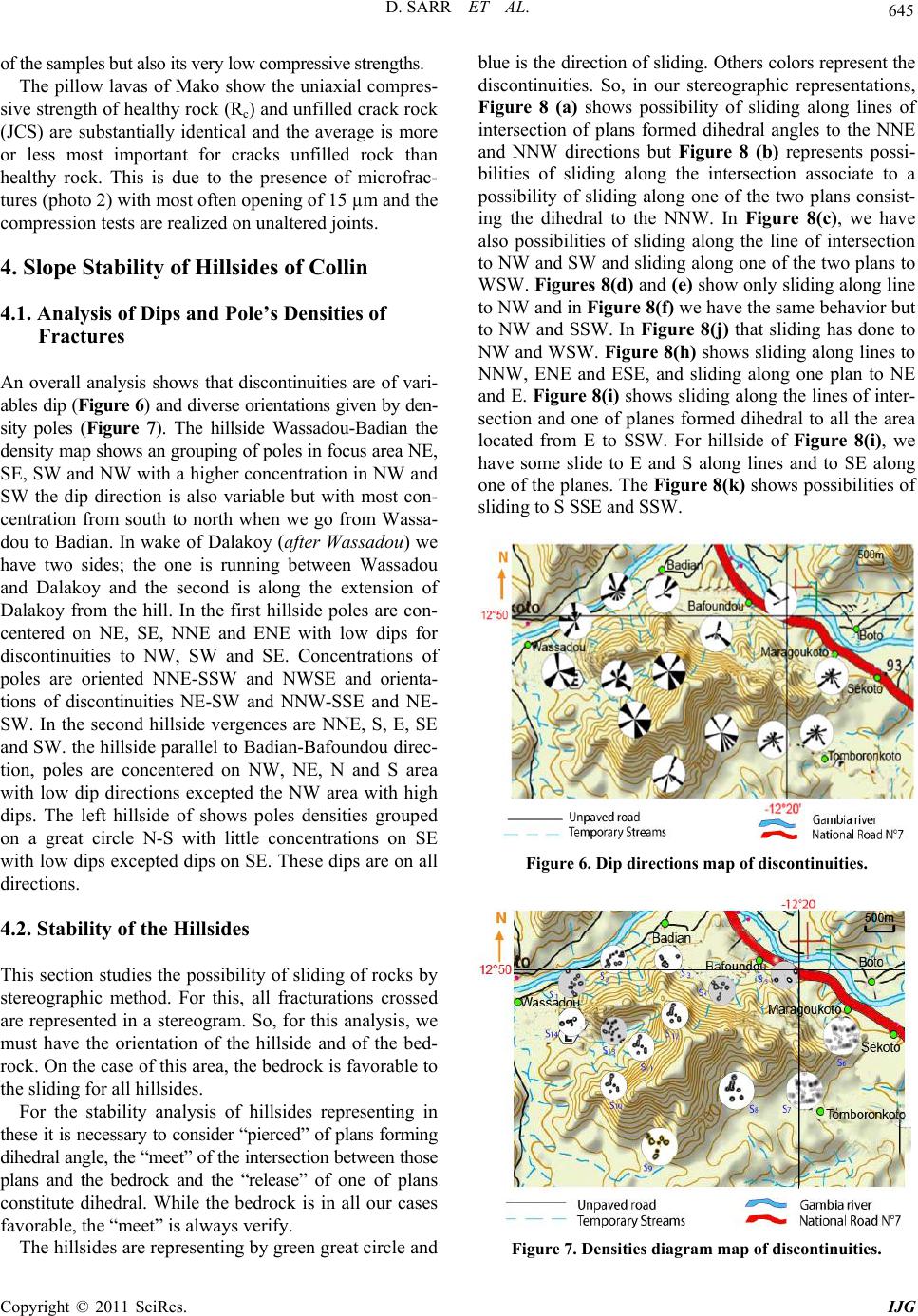 D. SARR ET AL. Copyright © 2011 SciRes. IJG 645 of the samples but also its very low compressive strengths. The pillow lavas of Mako show the uniaxial compres- sive strength of healthy rock (Rc) and unfilled crack rock (JCS) are substantially identical and the average is more or less most important for cracks unfilled rock than healthy rock. This is due to the presence of microfrac- tures (photo 2) with most often opening of 15 µm and the compression tests are realized on unaltered joints. 4. Slope Stability of Hillsides of Collin 4.1. Analysis of Dips and Pole’s Densities of Fractures An overall analysis shows that discontinuities are of vari- ables dip (Figure 6) and diverse orientations given by den - sity poles (Figure 7). The hillside Wassadou-Badian the density map shows an grouping of poles in focus area NE, SE, SW and NW with a higher concentration in NW and SW the dip direction is also variable but with most con- centration from south to north when we go from Wassa- dou to Badian. In wake of Dalakoy (after Wassadou) we have two sides; the one is running between Wassadou and Dalakoy and the second is along the extension of Dalakoy from the hill. In the first hillside poles are con- centered on NE, SE, NNE and ENE with low dips for discontinuities to NW, SW and SE. Concentrations of poles are oriented NNE-SSW and NWSE and orienta- tions of discontinuities NE-SW and NNW-SSE and NE- SW. In the second hillside vergences are NNE, S, E, SE and SW. the hillside parallel to Badian-Bafoundou d irec- tion, poles are concentered on NW, NE, N and S area with low dip directions excepted the NW area with high dips. The left hillside of shows poles densities grouped on a great circle N-S with little concentrations on SE with low dips excepted dips on SE. These dips are on all directions. 4.2. Stability of the Hillsides This section studies the possibility of sliding of rocks by stereographic method. For this, all fracturations crossed are represented in a stereogram. So, for this analysis, we must have the orientation of the hillside and of the bed- rock. On the case of this area, the bedrock is favorable to the sliding for all hillsides. For the stability analysis of hillsides representing in these it is necessary to cons ider “pierced” of plans forming dihedral angle, the “meet” of the intersection between those plans and the bedrock and the “release” of one of plans constitute dihedral. While the bedrock is in all our cases favorable, the “meet” is always verify. The hillsides are representing by green great circle and blue is the direction of sliding. Others colors represent the discontinuities. So, in our stereographic representations, Figure 8 (a) shows possibility of sliding along lines of intersection of plans formed dihedral angles to the NNE and NNW directions but Figure 8 (b) represents possi- bilities of sliding along the intersection associate to a possibility of sliding along one of the two plans consist- ing the dihedral to the NNW. In Figure 8(c), we have also possibilities of sliding along the line of intersection to NW and SW and sliding along one of the two plans to WSW. Figures 8(d) and (e) show only sliding along line to NW and in Figure 8(f) we have the same behavior but to NW and SSW. In Figure 8(j) that sliding has done to NW and WSW. Figure 8(h) shows sliding along lines to NNW, ENE and ESE, and sliding along one plan to NE and E. Figure 8(i) shows sliding along the lines of inter- section and one of planes formed dihedral to all the area located from E to SSW. For hillside of Figure 8(i), we have some slide to E and S along lines and to SE along one of the planes. The Figure 8(k) shows possibilities of sliding to S SSE and SSW. Figure 6. Dip directions map of discontinuities. Figure 7. Densities diagram map of discontinuities. 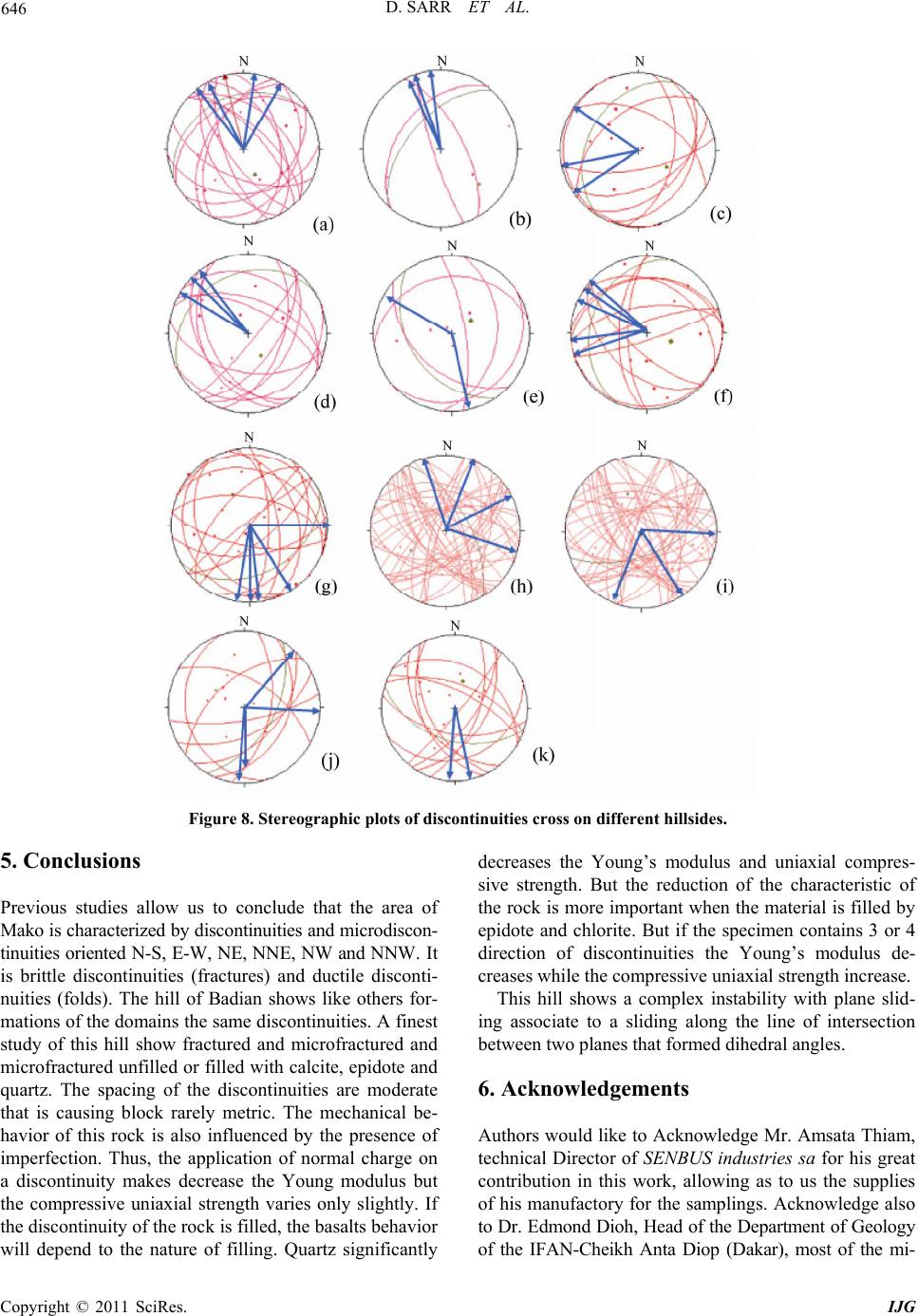 D. SARR ET AL. Copyright © 2011 SciRes. IJG 646 Figure 8. Stereographic plots of discontinuities cross on different hillsides. 5. Conclusions Previous studies allow us to conclude that the area of Mako is characterized by discontinuities and microdiscon- tinuities oriented N-S, E-W, NE, NNE, NW and NNW. I t is brittle discontinuities (fractures) and ductile disconti- nuities (folds). The hill of Badian shows like others for- mations of the domains th e same discontinu ities. A finest study of this hill show fractured and microfractured and microfractured unfilled or filled with calcite, epido te and quartz. The spacing of the discontinuities are moderate that is causing block rarely metric. The mechanical be- havior of this rock is also influenced by the presence of imperfection. Thus, the application of normal charge on a discontinuity makes decrease the Young modulus but the compressive uniaxial strength varies only slightly. If the discontinuity of th e ro ck is filled , the ba salts beh av ior will depend to the nature of filling. Quartz significantly decreases the Young’s modulus and uniaxial compres- sive strength. But the reduction of the characteristic of the rock is more important when the material is filled by epidote and chlorite. But if the specimen contains 3 or 4 direction of discontinuities the Young’s modulus de- creases while the compressive uniaxial strength increase. This hill shows a complex instability with plane slid- ing associate to a sliding along the line of intersection between two planes that formed dihedral angles. 6. Acknowledgements Authors would like to Acknow ledge Mr. Amsata Thiam, technical Director of SENBUS industries sa for his great contribution in this work, allowing as to us the supplies of his manufactory for the samplings. Acknowledge also to Dr. Edmond Dioh, Head of the Department of Geology of the IFAN-Cheikh Anta Diop (Dakar), most of the mi- 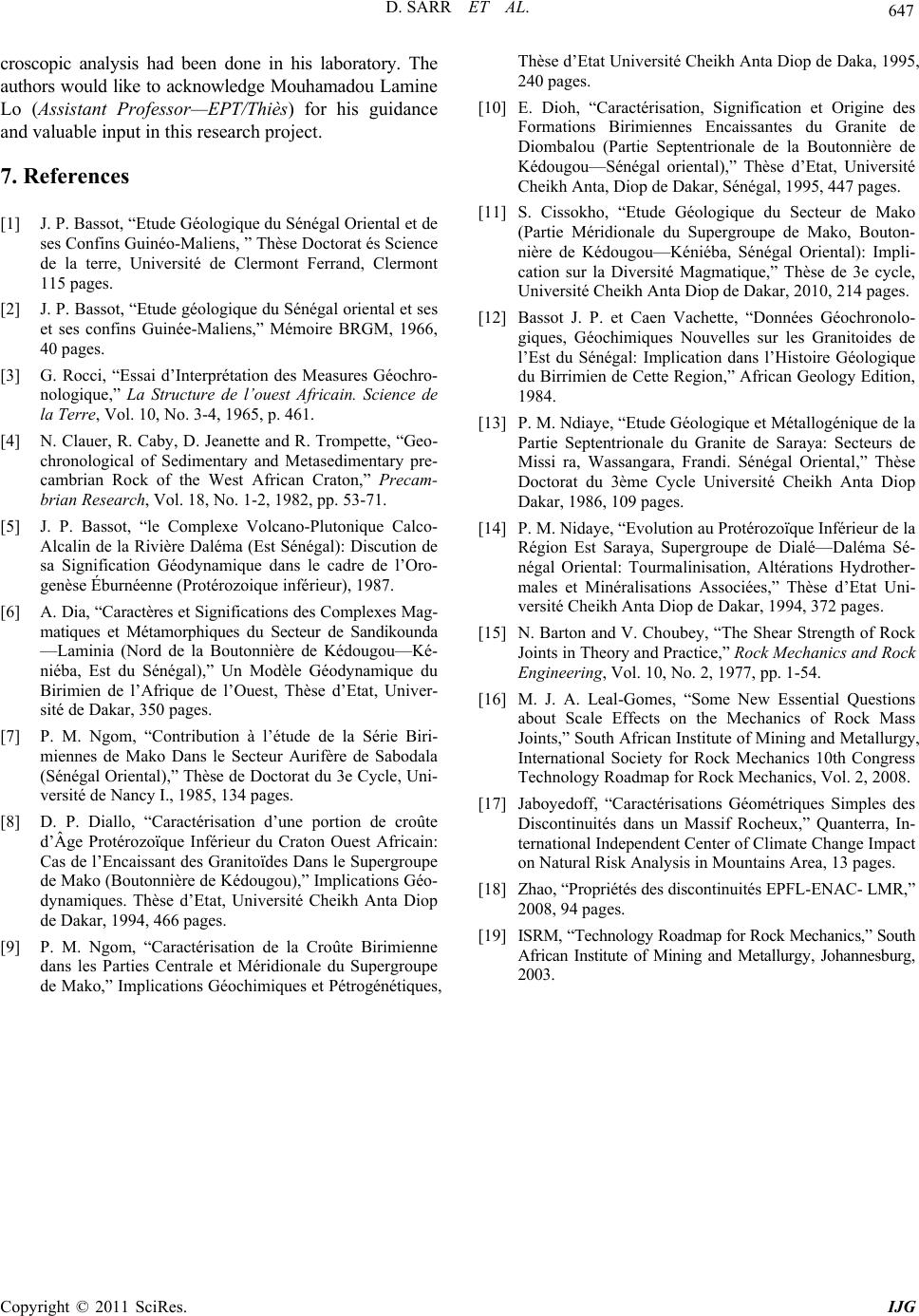 D. SARR ET AL. Copyright © 2011 SciRes. IJG 647 croscopic analysis had been done in his laboratory. The authors would like to acknowledge Mouhamadou Lamin e Lo (Assistant Professor—EPT/Thiès) for his guidance and valuable input in this research project. 7. References [1] J. P. Bassot, “Etude Géologique du Sénégal Oriental et de ses Confins Guinéo-Maliens, ” Thèse Doctorat és Science de la terre, Université de Clermont Ferrand, Clermont 115 pages. [2] J. P. Bassot, “Etude géologique du Sénégal oriental et ses et ses confins Guinée-Maliens,” Mémoire BRGM, 1966, 40 pages. [3] G. Rocci, “Essai d’Interprétation des Measures Géochro- nologique,” La Structure de l’ouest Africain. Science de la Terre, Vol. 10, No. 3-4, 1965, p. 461. [4] N. Clauer, R. Caby, D. Jeanette and R. Trompette, “Geo- chronological of Sedimentary and Metasedimentary pre- cambrian Rock of the West African Craton,” Precam- brian Research, Vol. 18, No. 1-2, 1982, pp. 53-71. [5] J. P. Bassot, “le Complexe Volcano-Plutonique Calco- Alcalin de la Rivière Daléma (Est Sénégal): Discution de sa Signification Géodynamique dans le cadre de l’Oro- genèse Éburnéenne (Pr otérozoique inférieur), 1987. [6] A. Dia, “Caractères et Significations des Complexes Mag- matiques et Métamorphiques du Secteur de Sandikounda —Laminia (Nord de la Boutonnière de Kédougou—Ké- niéba, Est du Sénégal),” Un Modèle Géodynamique du Birimien de l’Afrique de l’Ouest, Thèse d’Etat, Univer- sité de Dakar, 350 pages. [7] P. M. Ngom, “Contribution à l’étude de la Série Biri- miennes de Mako Dans le Secteur Aurifère de Sabodala (Sénégal Oriental),” Thèse de Doctorat du 3e Cycle, Uni- versité de Nancy I., 1985, 134 pages. [8] D. P. Diallo, “Caractérisation d’une portion de croûte d’Âge Protérozoïque Inférieur du Craton Ouest Africain: Cas de l’Encaissant des Granitoïdes Dans le Supergroupe de Mako (Boutonnière de Kédougou),” Implications Géo- dynamiques. Thèse d’Etat, Université Cheikh Anta Diop de Dakar, 1994, 466 pages. [9] P. M. Ngom, “Caractérisation de la Croûte Birimienne dans les Parties Centrale et Méridionale du Supergroupe de Mako,” Implications Géochimiques et Pétrogénétiques, Thèse d’Etat Université Cheikh Anta Diop de Daka, 1995, 240 pages. [10] E. Dioh, “Caractérisation, Signification et Origine des Formations Birimiennes Encaissantes du Granite de Diombalou (Partie Septentrionale de la Boutonnière de Kédougou—Sénégal oriental),” Thèse d’Etat, Université Cheikh Anta, Diop de Dakar, Sénégal, 1995, 447 pages. [11] S. Cissokho, “Etude Géologique du Secteur de Mako (Partie Méridionale du Supergroupe de Mako, Bouton- nière de Kédougou—Kéniéba, Sénégal Oriental): Impli- cation sur la Diversité Magmatique,” Thèse de 3e cycle, Université Cheikh Anta Diop de Dakar, 2010, 214 pages. [12] Bassot J. P. et Caen Vachette, “Données Géochronolo- giques, Géochimiques Nouvelles sur les Granitoides de l’Est du Sénégal: Implication dans l’Histoire Géologique du Birrimien de Cette Region,” African Geology Edition, 1984. [13] P. M. Ndiaye, “Etude Géologique et Métallogénique de la Partie Septentrionale du Granite de Saraya: Secteurs de Missi ra, Wassangara, Frandi. Sénégal Oriental,” Thèse Doctorat du 3ème Cycle Université Cheikh Anta Diop Dakar, 1986, 109 pages. [14] P. M. Nidaye, “Evolution au Protérozoïque Inférieur de la Région Est Saraya, Supergroupe de Dialé—Daléma Sé- négal Oriental: Tourmalinisation, Altérations Hydrother- males et Minéralisations Associées,” Thèse d’Etat Uni- versité Cheikh Anta Diop de Dakar, 1994, 372 pages. [15] N. Barton and V. Choubey, “The Shear Strength of Rock Joints in Theory and Practice,” Rock Mechanics and Rock Engineering, Vol. 10, No. 2, 1977, pp. 1-54. [16] M. J. A. Leal-Gomes, “Some New Essential Questions about Scale Effects on the Mechanics of Rock Mass Joints,” South African Institute of Mining and Metallurgy, International Society for Rock Mechanics 10th Congress Technology Roadmap for Rock Mechanics, Vol. 2, 2008. [17] Jaboyedoff, “Caractérisations Géométriques Simples des Discontinuités dans un Massif Rocheux,” Quanterra, In- ternational Independent Center of Climate Change Impact on Natural Risk Analysis in Mountains Area, 13 pages. [18] Zhao, “Propriétés des discontinuités EPFL-ENAC- LMR,” 2008, 94 pages. [19] ISRM, “Technol ogy Road map for R ock Mechani cs,” So uth African Institute of Mining and Metallurgy, Johannesburg, 2003. |

